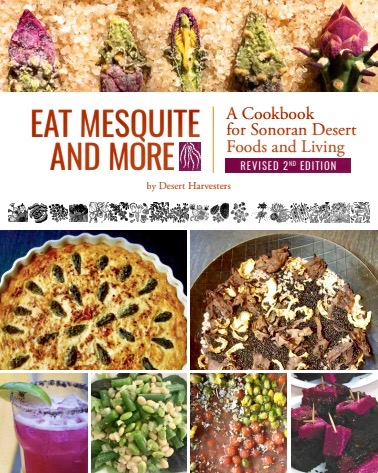
Blooming staghorn cholla and foothills palo verde bathe the Sonoran Desert in color. Surprisingly, this 2019 spring season has been so cool and moist that we are still harvesting cholla buds and fresh nopales in May. (MABurgess photo)
“Act now while this offer lasts!”–so says Mother Nature in the Sonoran Desert. She only offers her bounty in certain pulses or moments, and we must harvest while her “window of opportunity” is open. Tia Marta here to share some delectable ideas for serving your own desert harvest from our glorious bloomin’ cholla and prickly pears.

The YOUNGEST pads of new growth on prickly pear are the ones with tiny leaves at the areoles (where spines will later grow). (MABurgess photo)

After singe-ing off the tiny leaves and spiny glochids using tongs over a flame (either campfire or gas stove), slice and saute young prickly pear pads in olive oil. Now they are ready to use in lots of great recipes…(MABurgess photo)
Young prickly pear pads (many species in Baja Arizona) have no woody tissue yet developed inside. In their youthful stage (see photo) they are not only edible but also super-nutritious! The photo is our native Engelmann’s prickly pear (Opuntia engelmannii) with flower buds forming. Traditional Tohono O’odham call the edible young pads nawi.
After spines and areoles are singed off you can chop and scramble nopalitos with eggs, bake them into a quiche, pickle them, OR simmer them in a delicious mole sauce….The fastest and easiest way to prep a gourmet nopalito meal is to use Mano y Metate’s Mole Mixes. Savor blog writer Amy Valdes Schwemm has created several different sabores of mole–many without chocolate. My sweetie loves Amy’s Mole Adobe as its savory spice binder is pumpkin seeds with no tree nuts.

Nopalitos in Mano y Metate Mole Adobo sauce–here served with a mesquite tortilla (from Tortilleria Arevalo available at farmers’ markets in Tucson.) Nopalitos en Mole over brown rice is delicious too.
Get out your tongs and whisk brooms to harvest the last of the cholla buds this season!

A staghorn cholla cactus flower bud (Cylindropuntia versicolor) still with spines in need of cleaning. Buds with petals not yet open are the ones to pick–carefully.(MABurgess)

A harvest of staghorn cholla buds in screen box to remove spines from areoles (MABurgess photo)
Tohono O’odham harvesters know this cholla species as ciolim–pronounce it chee’o-lim.
Once de-spined, cholla buds must be boiled or roasted to denature its protective oxalic acid. Then, tah-dah!, cholla buds lend themselves to wonderful recipes similar to nopalitos in omelettes, quiches, stir-fries… They are flavorfully exotic, tangy, definitely nutritious containing gobs of available calcium and energy-sustaining complex carbs!

Pickled cholla buds (MABurgess photo)
I love to pickle my fresh cholla buds to enjoy later as garnish for wintertime dishes. For the salad recipe below, I’d canned them with pickling spices, but an easier alternative is to marinate them short-term for 24-48 hours in your favorite dressing for a quick fix.
Muff’s Easy Marinated Cholla Bud and Sonoran Wheat-berry Salad Recipe:
First–prep ahead–heirloom White Sonoran Wheat-berries: boil 1 cup dry wheat-berries in 4 cups drinking water for 1 hour 15 minutes, or until water is fully absorbed and grains are puffed up, then chill.
Also prep ahead— marinate fresh boiled cholla buds in pickle juice, or your favorite marinade or salad dressing for 24-48 hours in refrigerator.
Then–Chop any combination of your favorite fresh veggies–sweet peppers, tomatoes, summer squash, celery, carrots, artichoke hearts, etc….
Toss veggies with cooked chilled wheat-berries and marinated cholla buds. Add spices and pinyones if desired. Dress with remaining cholla marinade. Allow to chill before serving, neat or on a bed of fresh salad greens.

The yummiest cholla bud and wheat-berry marinated salad ever! (MABurgess photo)
Let’s honor, tend, and enjoy these desert foods that have fed generations of desert people for hundreds–thousands–of years, keeping them healthy and strong! Thanks to traditional harvesters, newcomers can more deeply appreciate and take good care of this beautiful desert.
An energy-saving idea: You can save energy and keep the heat out of the kitchen this summer by cooking your cholla buds or your wheat-berries in a solar oven! Check out a light-weight streamlined model solar oven at www.flordemayoarts.com.
[White Sonora Wheat-berries are available at NativeSeedsSEARCH store, 3061 N.Campbell Avenue, Tucson. Not to fret if cholla and prickly pear harvests are done for this spring in your neighborhood! During the rest of the year, you can find dried cholla buds at NativeSeedsSEARCH, at San Xavier Coop, OldTown Artisans, and at Flor de Mayo and fresh nopales in the Mexican foods section at groceries like Food City.]






















































































